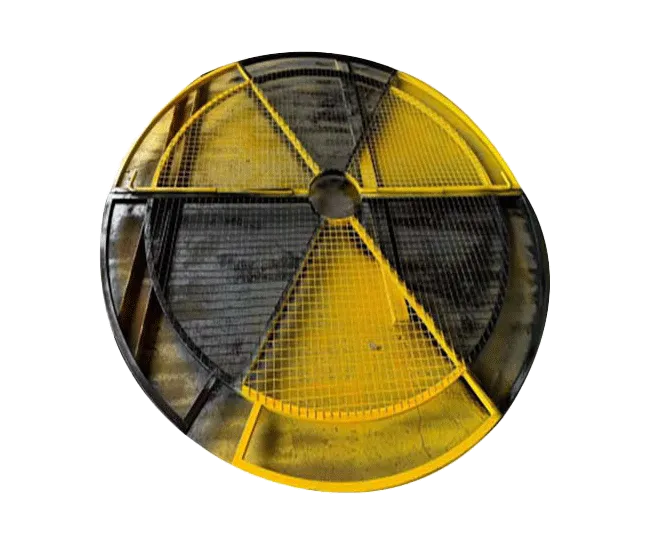Products Description
Hole Opening Protection: A Safety Barrier for High-Altitude and Underground Operations
In construction, mining, underground engineering, and other work scenarios, various holes (such as elevator shafts, reserved openings, pipe wells, and foundation pit edges) are high-risk areas prone to falling accidents. Hole opening protection, as a safety measure for such dangerous points, forms a reliable safety barrier by setting up physical isolation or blocking devices. It prevents people and materials from accidentally falling, and avoids secondary injuries caused by external objects falling into the holes, serving as a core protective means to ensure the safety of the working environment.
I. Materials and Types of Protective Devices: Safety Designs Adapted to Scenarios
The materials of hole opening protection devices should be selected according to the type of hole, the environment (such as indoor, outdoor, humid areas), and load requirements. Common types and corresponding devices include:
- Steel protective devices: Welded from Q235 carbon structural steel or Q355 low-alloy high-strength steel, such as protective railings, covers, and safety doors. Steel has high strength and strong impact resistance, suitable for scenarios with large loads (such as elevator shafts and deep foundation pit edges), and can withstand people leaning on or materials hitting without deformation.
- Aluminum alloy protective devices: Assembled from lightweight aluminum alloy profiles, they are light in weight and corrosion-resistant, often used for indoor reserved openings (such as floor holes) or temporary protection. They are easy to install and disassemble, suitable for scenarios requiring frequent movement.
- Composite material protective devices: Mainly made of fiberglass-reinforced plastic (FRP), they have both corrosion resistance and insulation, suitable for humid environments (such as underground pipe wells) or areas with electrical safety requirements, avoiding electric shock risks that may be caused by metal materials.
- Wooden protective devices: Made of anti-corrosion treated hardwood, such as temporary covers. They are low in cost but have limited strength, only suitable for small indoor shallow holes with minimal loads (such as small reserved holes for equipment), and their anti-corrosion effect needs to be checked regularly.
According to the shape and position of the holes, protective devices are mainly divided into three categories:
- Covers: For planar holes (such as reserved floor holes and ground inspection holes), covers are used to completely cover the holes, with edges extending at least 10cm beyond the periphery of the holes. They are fixed with bolts or buckles to prevent displacement. The surface of the covers is usually painted with warning colors and marked with signs such as "No Trespassing".
- Railings: Suitable for vertical or edge holes (such as elevator shafts and foundation pit edges), protective railings with a height of no less than 1.2m are set. The distance between vertical poles is no more than 2m, the distance between horizontal poles is no more than 60cm, and 18cm high toe boards are added at the bottom to prevent people from tripping or materials from rolling down.
- Safety doors: Designed specifically for holes that need to be opened frequently, such as elevator shafts and pipe wells. They adopt openable iron doors or steel mesh doors. When closed, they form closed protection with railings; when opened, they are equipped with interlocking devices to ensure they will not close accidentally during work and lock automatically when not in use.
II. Core Functions: The Safety Logic of Double Protection
The core role of hole opening protection is to build a two-way safety defense line of "fall prevention" and "prevention of falling into", specifically reflected in:
- Preventing people from falling: Through the physical isolation of covers or railings, it blocks people from accidentally entering the hole area due to negligence, slipping, or operational errors. Especially in night or low-light environments, warning signs and reflective strips can enhance visibility and remind of danger in advance.
- Blocking materials from falling: Covers or toe boards can prevent tools, building materials, and other materials from falling from the hole opening, avoiding injuries to workers under the hole (such as construction workers in elevator shafts and underground pipeline maintenance workers).
- Temporary work channels: Some load-bearing covers (such as steel grid covers), on the premise of ensuring fixation, can be used as temporary channels for people or small equipment to pass through, taking into account both protection and operational convenience.
- Environmental isolation: In the protection of outdoor holes (such as rainwater wells and sewage wells), covers can also prevent rainwater and debris from entering the holes to cause blockage, or avoid small animals from straying into and causing safety hazards.
Whether it is an elevator shaft in high-rise building construction or an underground pipe well in municipal engineering, hole opening protection is a key link in blocking the transmission of danger.
III. Applicable Scenarios and Targeted Protection Requirements
Different types of holes need to be matched with exclusive protection schemes. Common scenarios and requirements are as follows:
- Elevator shafts: Each floor's elevator shaft door must be equipped with a normally closed safety door with a height of 1.8m. The door body is closed with steel plate mesh or dense mesh, a toe board is set at the bottom, and a horizontal safety net is added every two floors (no more than 10m) in the shaft to prevent secondary injuries during falling.
- Reserved floor holes: For holes with a side length or diameter less than 50cm, they are covered and fixed with covers; for holes larger than 50cm, in addition to covers, protective railings need to be set around them; if the hole is near a passage, dense safety nets must be hung outside the railings.
- Foundation pits and slopes: Stacking is strictly prohibited within 1m of the foundation pit edge. Continuous protective railings are set, warning signs are hung inside the railings, red warning lights are installed at night, and inspections need to be intensified in severe weather such as heavy rain to prevent the protection from failing due to slope collapse.
- Pipe wells: For pipe wells with a diameter larger than 30cm (such as cable wells and ventilation wells), openable safety doors are installed at the wellheads with a height of no less than 1.5m. A safety net is set every 3m in the well, and no materials can be stacked within 50cm of the wellhead.
- Staircase and passage openings: Protective railings are set at the edge of the staircase platform. A protective shed is built above the passage opening, with a double-layer scaffold board or steel plate on the shed top, spaced 50cm apart. The length is determined according to the falling radius (generally 3-6m) to prevent high-altitude falling objects from hitting.
IV. Installation and Management Points: The Key to Dynamic Protection
The effectiveness of hole opening protection not only depends on the device itself but also on standardized installation and dynamic management:
- Installation accuracy: The cover must fit closely with the edge of the hole, with a gap of no more than 5mm; the vertical poles of the railings must be embedded in the ground or welded firmly with structural embedded parts, with a verticality deviation of no more than 1°; the opening direction of the safety door should face the working area to avoid hindering escape.
- Warning signs: The surface of all protective devices must be painted with yellow-black warning colors. The bearing capacity is marked on the cover (such as "Load limit 500kg"). Signs such as "Caution" and "No Climbing" are hung outside the railings, and reflective strips or warning lights are added at night or in dark places.
- Dynamic inspection: Check the integrity of protective devices before work every day, focusing on whether the cover is loose, the railing is deformed, and the safety door can be locked normally; comprehensive re-inspection is required after extreme weather such as strong winds and heavy rains, and damaged parts are repaired in time.
- Temporary removal management: When protective devices need to be removed for work, approval procedures must be gone through, temporary supervisors should be assigned, a warning area should be set around the hole, and the protection must be restored immediately after work. No unprotected state is allowed overnight.
Summary
Although hole opening protection is an "auxiliary facility" in construction, it is the "lifeline" of safety management. It resists external impact with the strength of materials, blocks dangerous paths with structural design, and builds an invisible safety boundary in complex working environments. From the size of the cover to the height of the railing, from the position of warning signs to the frequency of daily inspections, every detail carries the protection of life safety. In today's emphasis on safe production, standardizing the design, installation, and management of hole opening protection is not only a basic requirement for complying with regulations but also a direct manifestation of corporate responsibility and humanistic care, building a solid safety line for every worker.



